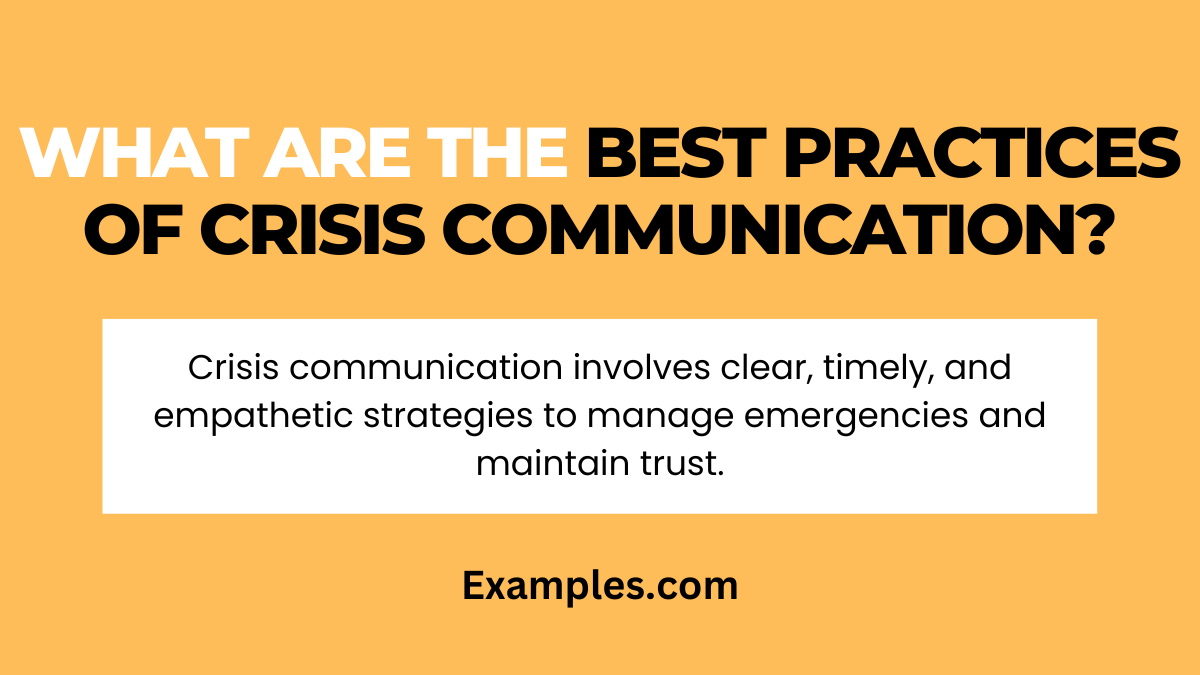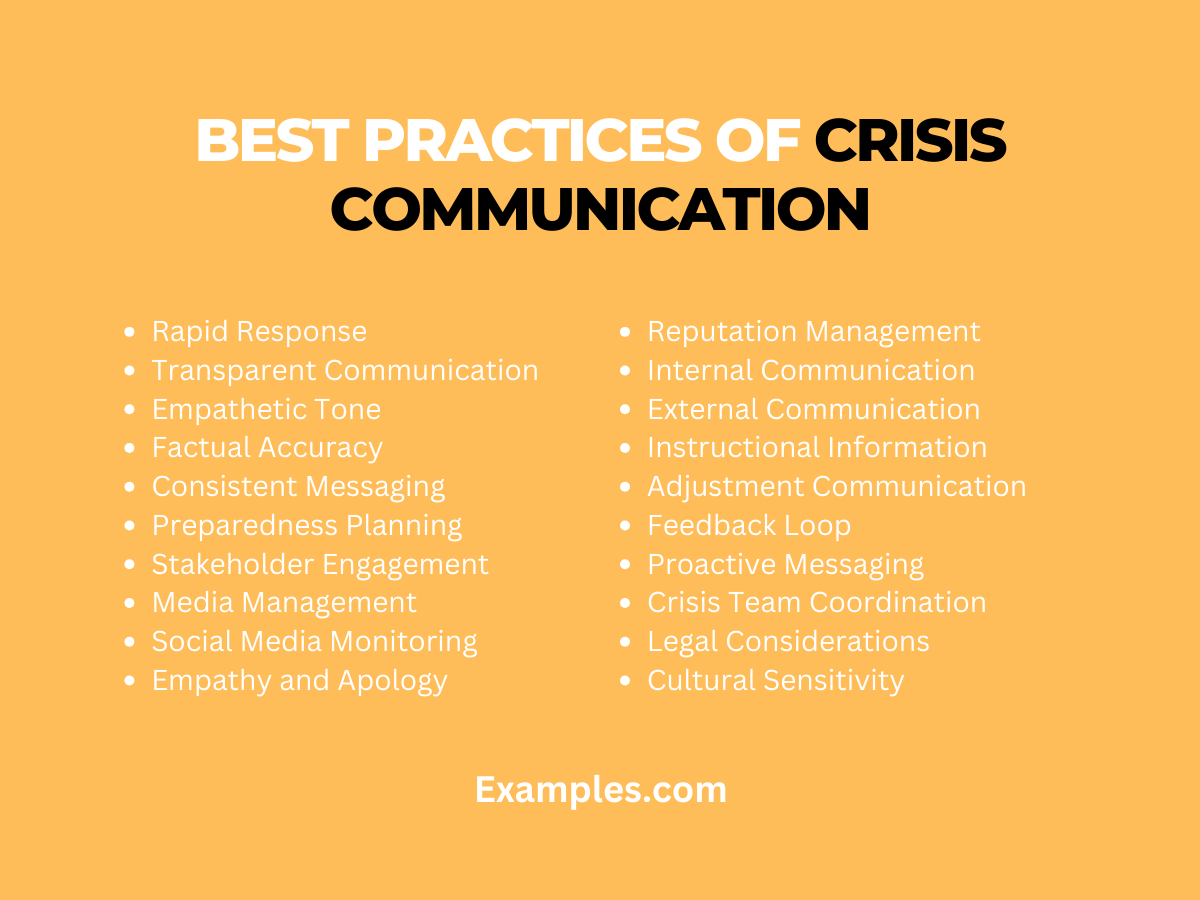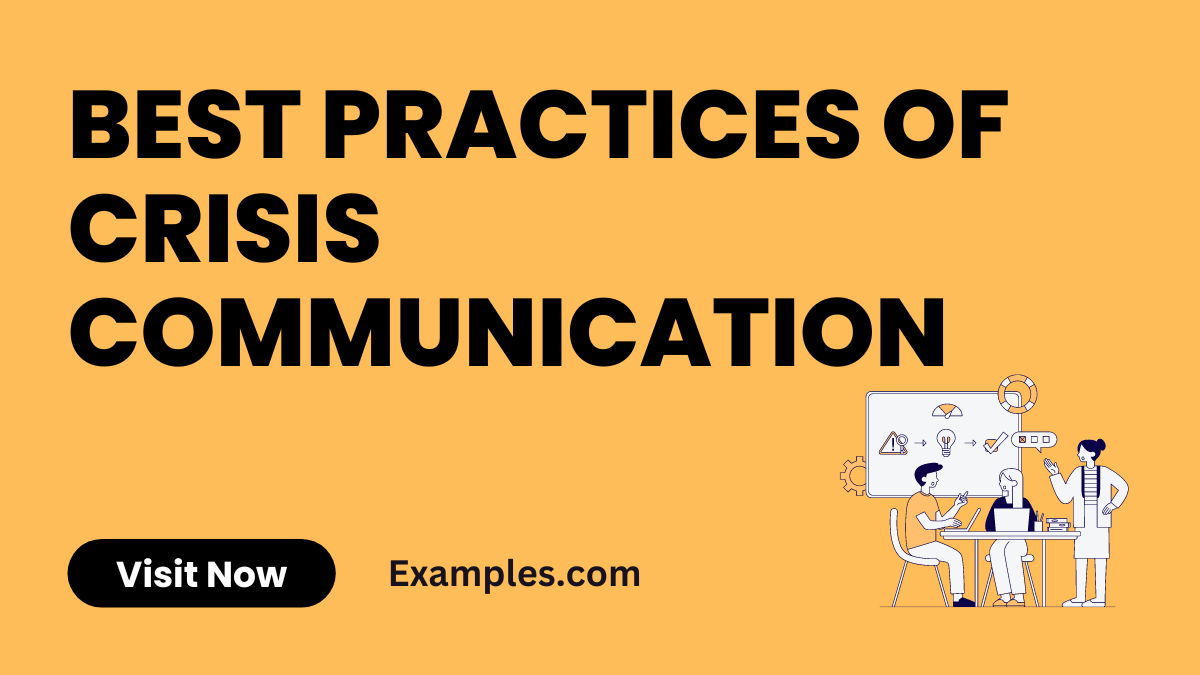24+ Best Practices of Crisis Communication Examples
In the intricate world of Oral Communication, understanding the best practices of crisis communication is indispensable. This section sheds light on the critical techniques and strategies necessary for handling crises efficiently. From establishing clear communication channels to maintaining a calm and empathetic tone, these best practices are essential tools. They empower individuals and organizations to manage crisis situations effectively, ensuring messages are delivered with clarity and precision, preserving trust and credibility.
What are the Best Practices of Crisis Communication?

Crisis communication refers to the strategies and tactics used by individuals or organizations to communicate effectively during emergencies or challenging situations. It involves delivering clear, concise, and accurate information to the right audience at the right time. The best practices in crisis communication include preparing in advance, being transparent, responding rapidly, maintaining consistent messaging, and engaging with stakeholders empathetically. These practices are designed to manage and mitigate the impact of a crisis, preserving trust and credibility.
25 Best Practices of Crisis Communication

Mastering crisis communication is crucial in Interpersonal Communication. It’s about delivering the right message at the right time with clarity and empathy. This comprehensive guide covers 25 best practices in crisis communication, each illustrated with a unique example showing how to implement these strategies effectively.
- Rapid Response
Example: “We are immediately addressing the situation and will keep you updated.” - Transparent Communication
Example: “We pledge full transparency as more information becomes available.” - Empathetic Tone
Example: “We hear your concerns and are truly sorry for any inconvenience caused.” - Factual Accuracy
Example: “Here are the facts based on our current understanding…” - Consistent Messaging
Example: “Our commitment to safety remains our top priority, as always stated.”

- Preparedness Planning
Example: “Our contingency plans are now being implemented to address this issue.” - Stakeholder Engagement
Example: “We value the input of all stakeholders and are actively engaging with them.” - Media Management
Example: “An official press release with accurate updates will be issued shortly.” - Social Media Monitoring
Example: “We are actively monitoring social channels to correct any false information.” - Empathy and Apology
Example: “We deeply regret the incident and are dedicated to resolving it.” - Reputation Management
Example: “We are focused on maintaining our record of reliability and trust.” - Internal Communication
Example: “Team, here’s the current status and our approach to manage it.” - External Communication
Example: “Customers, we are taking these actions to resolve the current issue.” - Instructional Information
Example: “For your safety, please adhere to the following guidelines…” - Adjustment Communication
Example: “As new information emerges, our strategy will be updated accordingly.” - Feedback Loop
Example: “We welcome your input to help us navigate this situation better.” - Proactive Messaging
Example: “We’re implementing measures to prevent similar issues in the future.” - Crisis Team Coordination
Example: “Our dedicated crisis team is working tirelessly for a resolution.”

- Legal Considerations
Example: “All actions are being taken in line with legal guidance.” - Cultural Sensitivity
Example: “We are approaching this matter with full respect for cultural diversity.” - Technological Utilization
Example: “We’re leveraging technology to ensure effective communication.” - Human Element
Example: “Our focus on people’s wellbeing remains our guiding principle.” - Post-Crisis Analysis
Example: “Post-crisis, we will evaluate our response to learn and improve.” - Continuous Improvement
Example: “Our commitment to evolving our crisis response strategies is unwavering.” - Resource Allocation
Example: “Adequate resources have been mobilized to manage this crisis effectively.”
Best Practices of Crisis Communication Techniques
In the realm of Crisis Communication, mastering effective techniques is crucial for successfully navigating challenging situations. These practices ensure that your message is clear, timely, and received as intended, maintaining trust and control during crises.
- Rapid Response: Implement immediate action to address the crisis and minimize impact.
- Transparent Communication: Ensure openness and honesty in all messaging.
- Empathy and Apology: Show understanding and, if necessary, apologize sincerely.
- Factual Accuracy: Guarantee all information shared is accurate and verified.
- Consistent Messaging: Keep a unified message across all communication channels.
- Stakeholder Engagement: Actively involve and communicate with all affected parties.
- Media Management: Handle media inquiries and press releases effectively.
- Social Media Monitoring: Track and manage the narrative on social platforms.
- Preparedness Planning: Have a crisis management plan ready in advance.
- Post-Crisis Evaluation: Assess the response and learn from the crisis.
Best Practices of Crisis Communication Stages
Understanding and implementing best practices in various stages of Crisis Communication can significantly influence the outcome. Each stage demands specific attention and strategy to ensure effective communication and crisis resolution.
- Pre-Crisis Preparation: Develop a comprehensive crisis management plan.
- Crisis Identification: Quickly recognize potential or emerging crises.
- Initial Response: Offer an immediate, strategic reaction.
- Ongoing Communication: Update stakeholders as the situation evolves.
- Stakeholder Engagement: Maintain constant dialogue with impacted parties.
- Media Relations: Proactively manage interactions with the media.
- Message Adaptation: Adjust messages as new information becomes available.
- Resolution Announcement: Clearly communicate when the crisis is resolved.
- Post-Crisis Analysis: Review and assess the crisis management efforts.
- Feedback Integration: Use lessons learned in future planning.
Best Practices of Crisis Communication Elements
The elements of crisis communication form the foundation of effective management in crisis situations. These elements are vital in ensuring that the communication strategy is robust and resilient in the face of challenges.
- Clear Objectives: Set specific goals for Crisis Communication.
- Audience Identification: Recognize and understand the target audience.
- Message Development: Craft clear, concise, and relevant messages.
- Channel Selection: Choose effective mediums for communication.
- Tone Setting: Ensure the tone is appropriate for the situation.
- Timing Consideration: Time messages for maximum impact.
- Feedback Mechanisms: Implement ways to receive and process feedback.
- Team Collaboration: Work with a dedicated crisis communication team.
- Resource Allocation: Ensure adequate resources for communication.
- Continuous Monitoring: Keep track of the situation and public perception.
Each point addresses key aspects of managing communication during a crisis, highlighting the importance of strategy, clarity, and empathy in all interactions.
Mastering the best practices of crisis communication is vital for effective Interpersonal Communication in challenging situations. This guide has provided essential tips and strategies, equipping you with the knowledge to navigate crises with confidence. Remember, clear, empathetic, and strategic communication is key to maintaining trust and managing crises effectively. Embrace these practices to ensure a resilient and responsive approach in any crisis.



